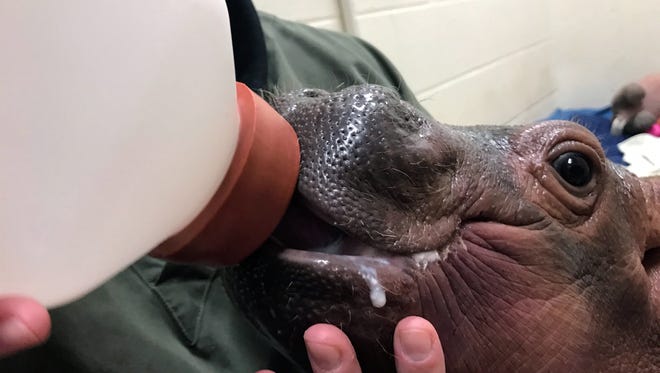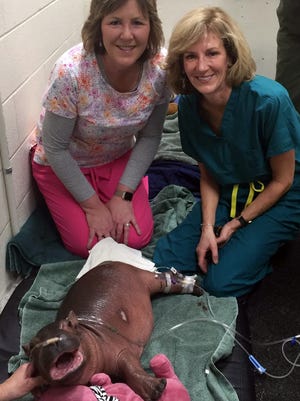The science behind milking a hippo, saving baby Fiona

CINCINNATI — Pressing her face up against Bibi's suitcase-leather skin from the safety of a barrier, Jessye Wojtusik reached up and under the animal, awkwardly trying to access her udders.
Never could she have imagined that her post-doctoral research would find her milking a 3,371-pound hippo.
But with the birth of Fiona, the Cincinnati Zoo & Botanical Gardens' beloved baby hippo, convention has been in short supply. No one has a handbook for hand-rearing a hippo.
But thanks to the efforts of people like Wojtusik, a postdoctoral researcher/scientist at the zoo's Center for Conservation and Research of Endangered Wildlife, Fiona's keepers, the zoo's nutritionist and a scientist at the "milk bank" at Smithsonian's National Zoo a handbook will be created.
► Earlier: Cincinnati's premie hippo gets help from human hospital
► Earlier: Cincinnati Zoo's premature hippo Fiona takes first steps
Fiona, born Jan. 24, was the first Nile hippo born at the Cincinnati Zoo in 75 years. She weighed 29 pounds at birth, about 25 pounds lighter than the lowest recorded birth weight for her species.
The normal range for a baby hippo of her species 55 to 120 pounds. But before Fiona came into the world six weeks early and only about half as big as she should have been, zoo staff were getting ready for her care.
A birth plan is standard when a zoo baby is on the way. Much of that went out the window when newborn Fiona was too small and too weak to nurse from her mother.
Staff members had to take quick action. They reached out to contacts at other zoos to see if anyone had hand-reared a hippo.
No one had.
Getting Fiona's strength up was critical, and that meant making sure she had the right nutrients. Here, the zoo had an unusual advantage: They figured they just might be able to milk her mother.
Keepers already had trained Bibi to go into a small enclosure and "lean in" for an ultrasound. That was a breakthrough in itself.
Wojtusik had captured what is believed to the first-ever ultrasound image of a Nile hippo fetus.
Were it not for that, it would have been difficult, if not impossible, to train a mother hippo for milking after she gave birth. But from Bibi's perspective, being milked wasn't all that different an experience from getting an ultrasound.
► Baby whales: SeaWorld's last orca calf will be born soon
► Watch live: New York's baby giraffe due any time
Picture it: One keeper stood to Bibi's side, holding a ball on a stick. When the hippo leaned far enough to touch it — in other words, the desired behavior — a keeper in front gave her treats like beet pulp, apples and romaine lettuce.
"Bibi’s really food motivated," Wojtusik said. "She'll do pretty much anything for a treat."

She's also surprisingly cooperative for a hippo.
"I don’t think it would have been possible with very many hippos," Wojtusik said. "I think if we tried (something like this) with Henry (Fiona's father), it would be a different story."
While Bibi was busy eating, Wojtusik and later keepers could milk her. Growing up on a farm, Wojtusik occasionally milked pigs and cows.
Hippo udders, she found out, are shaped more like ones on pigs. The gentle squeezing motion wasn't that different with Bibi, once Wojtusik had succeeded at the reaching part.
Africa keeper Wendy Rice is pretty sure no zoo hippo has voluntarily allowed herself to be milked before now. Keepers milked Bibi twice a day most days until she stopped lactating.
They didn't get a huge amount of milk, certainly not enough to sustain a baby hippo, but what they did get was significant for more than one reason.
First, it was good for Fiona.
"It’s really important that newborns get the 'first milk,' the colostrum," Wojtusik said. "It helps their immune system and provides them the antibodies they need."
► Baby leopard: First-ever clouded leopard born via artificial insemination
► Baby skunks: These baby skunks are so stinkin’ cute!
Second, not all of Bibi's milk went to Fiona.
Zoo staff sent just a little of it to Front Royal, Va., to a scientist named Michael Power at the Smithsonian National Zoo. He runs the milk repository at the Smithsonian Conservation Biology Institute’s Conservation Ecology Center, about 70 miles west of the District of Columbia.
Yes, the national zoo has a national milk bank with no fewer than 15,000 milk samples from at least 130 different mammal species.
Power's goal is to collect multiple milk samples from multiple females of a species.
He wants to find out how that milk changes over time, and if individuals in a species have different milk. In other words, is gorilla milk gorilla milk, or is each animal different?
He already knows about species' differences in things like sugar and fat content. He can tell the difference between human and primate milk, or gorilla milk and orangutan milk, just by the microbes in it.
But until he got Bibi's milk — samples from days 1, 3, 8 and 9 — he never had seen hippo milk before.
Turns out it's on the high side for protein and relatively low in fat and sugar. The closest milk to it that he's seen is from a giant anteater.
That's interesting to science, sure. But this particular case was about more than advancing understanding of animal physiology.
Back at the Cincinnati Zoo, curator of nutrition Barbara Henry waited for the results.
► Baby giraffe: See the birth of giraffe at Des Moines zoo
► Baby rhino: Rare black rhino born at Des Moines zoo
Barbara Henry is one of only a small number of zoo nutritionists in North America. In a case like Fiona's, she works with a company that makes formulas to resemble different animals' milk, based on scientific research.
But Barbara Henry doesn't just take the company at its word: She does her due diligence and checks their research.

In this case, all anyone had to go on was a less-than-specific research paper from 1959. That wasn't enough evidence to gamble with Fiona's health.
Getting a formula right takes a lot of trial and error anyway. Keepers and vets looked at everything from her weight gain or lack thereof to her energy level to her blood work to her poo, meeting multiple times a day to determine what she might be lacking and how they might change her food to fix that.
"You have all these pieces to the puzzle, and you have to figure out how to put the puzzle together," Barbara Henry said. "And the picture may change the next day."
Power's analysis gave them a clearer picture to start with, the knowledge of exactly what Fiona would have been getting had she been able to nurse. He found that the 1959 report overestimated the fat content.
That's good for Fiona, and for future Fionas.
This learning curve is one all involved were happy to surmount. For scientists like Power and Wojtusik, who spend most of their time on lab work and writing, it was rewarding to work on something with a practical application, particularly when it meant helping a much-loved baby animal.
► Baby pandas: Alert! Toronto Zoo has twins
► Baby tigers: Watch sweet tiger cubs play at Columbus Zoo
And it's not every day that you get to milk a hippo.
"But I’m super excited that I did get the opportunity," Wojtusik said. "I’ve always loved hippos, so this has been kind of a dream for me."
Follow Shauna Steigerwald on Twitter: @shaunaincincy
